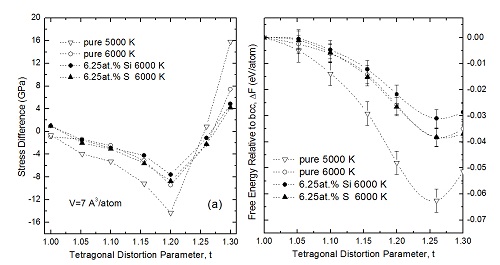The effect of Si and S on the stability of bcc iron with respect to tetragonal strain at the Earth’s inner core conditionsUpdate time:12 23, 2013
Ph. D. student CUI Hang and his teachers utilize thermodynamic integration techniques based on extensive first-principles molecular dynamics simulations to analyze the combining effects of high temperature and impurities on the stability of bcc structure with respect to tetragonal strain. The Earth's inner core is primarily composed of iron, but the stable crystalline structure of iron under core conditions still remains uncertain. The body-centered cubic (bcc) phase has been suggested as a possible candidate to explain the observed seismic complexity, but its stability at core conditions is highly disputed. According to their simulations, a small amount of Si/S permitted by seismological data at high temperature increases the stability of the bcc structure at high pressure, but not enough to achieve complete stability. This means the bcc-structured iron is highly unlikely to present in the Earth's inner core.
Figure 1. (a) Stress differences of bct lattice with respect to tetragonal strain under different conditions (128 atoms in the system). (b) Integrated free energies relative to bcc structure under different conditions. (Image by CUI) Cui et al. The effect of Si and S on the stability of bcc iron with respect to tetragonal strain at the Earth’s inner core conditions. Geophysical Research Letters, 2013, 40: 2958-2962, doi:10.1002/grl.50582 (Link)
|
Contact
Related Articles
Reference
|
-
SIMSSecondary Ion Mass Spectrometer Laboratory
-
MC-ICPMSMultiple-collector ICPMS Laboratory
-
EM & TEMElectron Microprobe and Transmission Electron Microscope Laboratory
-
SISolid Isotope Laboratory
-
StIStable Isotope Laboratory
-
RMPARock-Mineral Preparation and Analysis
-
AAH40Ar/39Ar & (U-Th)/He Laboratory
-
EMLElectron Microscopy Laboratory
-
USCLUranium Series Chronology Laboratory
-
SASeismic Array Laboratory
-
SEELaboratory of Space Environment Exploration Laboratory
-
PGPaleomagnetism and Geochronology Laboratory
-
BioMNSFrance-China Bio-mineralization and Nano-structure Laboratory

 Print
Print Close
Close
